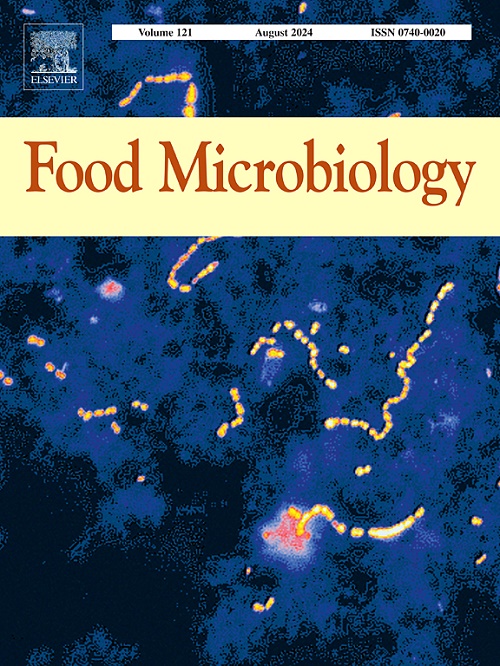Cross-over fermentation dynamics and proteomic properties of acid gels with indigenous Lactobacillus spp. isolated from cheeses
IF 4.5
1区 农林科学
Q1 BIOTECHNOLOGY & APPLIED MICROBIOLOGY
引用次数: 0
Abstract
The present study examined the proteomic characteristics and fermentation dynamics of indigenous bacteria isolated from traditional Mihalic cheese in an acid gel matrix. Accordingly, autochthonous strains of Levilactobacillus brevis, Lacticaseibacillus paracasei, and Lacticaseibacillus rhamnosus were adapted to the gel matrix alongside commercial yogurt culture (Streptococcus thermophilus and Lactobacillus delbrueckii subsp. bulgaricus). The study evaluated bacterial activity, proteolytic behavior, physicochemical characteristics, and textural and sensory properties in acid gel samples. The microorganisms demonstrated high survival rates (>7.35 log₁₀ cfu/g) in the fermented gel system and induced limited acidification throughout the product's shelf life. Regarding proteomic properties, the highest amino acid variation during the shelf life was observed in the FMB sample (28.20%). Furthermore, arginine, leucine, phenylalanine, aspartic acid, lysine, and cysteine reductions were noted in samples containing the isolated microorganisms. Including indigenous microorganisms in the fermented milk increased the levels of essential amino acids. Principal Component Analysis of sensory properties revealed that samples containing indigenous microorganisms differed significantly from the control sample (C), which contained only commercial yogurt culture. The results revealed the proteolytic changes associated with fermentation, including producing free amino acids as nutritional components, forming specific aroma compounds, and modifying textural and sensory properties. These results demonstrate the potential of utilizing local cultures to develop products enriched with novel bioactive components, offering consumers enhanced nutritional and sensory benefits.
从奶酪中分离的乳杆菌与酸性凝胶的交叉发酵动力学和蛋白质组学特性
本研究研究了从传统米哈利酸奶酪中分离的本地细菌在酸性凝胶基质中的蛋白质组学特征和发酵动力学。因此,将本土的短乳杆菌、副干酪乳杆菌和鼠李糖乳杆菌与商业酸奶培养物(嗜热链球菌和德尔布鲁氏乳杆菌亚种)一起适应于凝胶基质。发酵剂)保加利亚。该研究评估了酸性凝胶样品中的细菌活性、蛋白质水解行为、物理化学特性、结构和感官特性。微生物在发酵凝胶体系中表现出较高的存活率(>7.35 log₁₀cfu/g),并在产品的整个保质期内引起有限的酸化。在蛋白质组学特性方面,FMB样品在保质期内的氨基酸变化幅度最大(28.20%)。此外,在含有分离微生物的样品中发现了精氨酸、亮氨酸、苯丙氨酸、天冬氨酸、赖氨酸和半胱氨酸的减少。在发酵乳中加入本地微生物增加了必需氨基酸的水平。感官特性的主成分分析显示,含有本地微生物的样品与只含有商业酸奶培养物的对照样品(C)有显著差异。结果揭示了与发酵相关的蛋白质水解变化,包括产生作为营养成分的游离氨基酸,形成特定的香气化合物,以及改变结构和感官特性。这些结果证明了利用当地文化开发富含新型生物活性成分的产品的潜力,为消费者提供了更高的营养和感官效益。
本文章由计算机程序翻译,如有差异,请以英文原文为准。
求助全文
约1分钟内获得全文
求助全文
来源期刊

Food microbiology
工程技术-生物工程与应用微生物
CiteScore
11.30
自引率
3.80%
发文量
179
审稿时长
44 days
期刊介绍:
Food Microbiology publishes original research articles, short communications, review papers, letters, news items and book reviews dealing with all aspects of the microbiology of foods. The editors aim to publish manuscripts of the highest quality which are both relevant and applicable to the broad field covered by the journal. Studies must be novel, have a clear connection to food microbiology, and be of general interest to the international community of food microbiologists. The editors make every effort to ensure rapid and fair reviews, resulting in timely publication of accepted manuscripts.
 求助内容:
求助内容: 应助结果提醒方式:
应助结果提醒方式:


